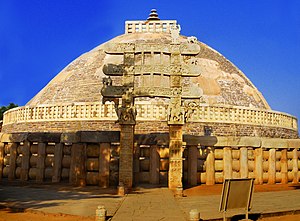| Buddhist Monuments at Sanchi* | |
|---|---|
| UNESCO World Heritage Site | |
 | |
| State Party | |
| Type | Cultural |
| Criteria | (i)(ii)(iii)(iv)(vi) |
| Reference | 524 |
| Region** | Asia-Pacific |
| Inscription history | |
| Inscription | 1989 (13th Session) |
| * Name as inscribed on World Heritage List. ** Region as classified by UNESCO. | |
Sanchi is a small village in Raisen District of the state of Madhya Pradesh, India, it is located 46 km north east of Bhopal, and 10 km from Besnagar and Vidisha in the central part of the state of Madhya Pradesh. It is the location of several Buddhist monuments dating from the third century BCE to the twelfth century CE and is one of the important places of Buddhist pilgrimage. It is a nagar panchayat in Raisen district in the Indian state of Madhya Pradesh. Toranas surround the Stupa and they each represent love, peace, trust, and courage.
The 'Great Stupa' at Sanchi was originally commissioned by the emperor Ashoka the Great in the third century BCE. Its nucleus was a simple hemispherical brick structure built over the relics of the Buddha. It was crowned by the chatra, a parasol-like structure symbolising high rank, which was intended to honour and shelter the relics.
Geography
Sanchi is located at 23°29′N 77°44′E / 23.48°N 77.73°E[2]. It has an average elevation of 434 metres (1423 feet).
History
Sunga period
| Sanchi | |
| | |
| Coordinates | 23°28′50″N 77°44′11″E / 23.480656°N 77.736300°E |
| Country | |
| State | Madhya Pradesh |
| District(s) | Raisen |
| Population | 6,785 (2001[update]) |
| Time zone | IST (UTC+5:30) |
The stupa was vandalized at one point, sometime in the second century BCE, an event some have related to the rise of the Sunga emperor Pusyamitra Sunga. It has been suggested that Pushyamitra may have destroyed the original stupa, and his son Agnimitra rebuilt it. During the later rule of the Sunga, the stupa was expanded with stone slabs to almost twice its original size. The dome was flattened near the top and crowned by three superimposed parasols within a square railing. With its many tiers it was a symbol of the dharma, the Wheel of the Law. The dome was set on a high circular drum meant for circumambulation, which could be accessed via a double staircase. A second stone pathway at ground level was enclosed by a stone balustrade with four monumental gateways (toranas) facing the cardinal directions. The buildings which seem to have been commissioned during the rule of the Sungas are the Second and Third stupas (but not the highly decorated gateways, which are from the following Satavahana period, as known from inscriptions), and the ground balustrade and stone casing of the Great Stupa.
Satavahana period
The gateways and the balustrade were built after 70 BCE, and appear to have been commissioned by the Satavahana. An inscription records the gift of one of the top architraves of the Southern Gateway by the artisans of the Satavahana king Satakarni:
- "Gift of Ananda, the son of Vasithi, the foreman of the artisans of rajan Siri Satakarni".
Although made of stone, they were carved and constructed in the manner of wood and the gateways were covered with narrative sculptures. They showed scenes from the life of the Buddha integrated with everyday events that would be familiar to the onlookers and so make it easier for them to understand the Buddhist creed as relevant to their lives. At Sanchi and most other stupas the local population donated money for the embellishment of the stupa to attain spiritual merit. There was no direct royal patronage. Devotees, both men and women, who donated money towards a sculpture would often choose their favourite scene from the life of the Buddha and then have their names inscribed on it. This accounts for the random repetition of particular episodes on the stupa (Dehejia 1992). On these stone carvings the Buddha was never depicted as a human figure. Instead the artists chose to represent him by certain attributes, such as the horse on which he left his father’s home, his footprints, or a canopy under the bodhi tree at the point of his enlightenment. The human body was thought to be too confining for the Buddha.
Some of the friezes of Sanchi also show devotees in Greek attire (Greek clothing, attitudes, and musical instruments) celebrating the stupa.
Later periods
Further stupas and other religious Buddhist and early Hindu structures were added over the following centuries until the 12th century CE. Temple 17 is probably one of the earliest Buddhist temples as it dates to the early Gupta period. It consists of a flat roofed square sanctum with a portico and four pillars. The interior and three sides of the exterior are plain and undecorated but the front and the pillars are elegantly carved, giving the temple an almost ‘classical’ appearance (Mitra 1971). With the decline of Buddhism in India, the monuments of Sanchi went out of use and fell into a state of disrepair.
Western rediscovery
A British officer in 1818, General Taylor, was the first known Western historian to document (in English) the existence of Sanchi (Sāñcī). Amateur archaeologists and treasure hunters ravaged the site until 1881, when proper restoration work was initiated. Between 1912 and 1919 the structures were restored to their present condition under the supervision of Sir John Marshall.
Today, around fifty monuments remain on the hill of Sanchi, including three stupas and several temples. The monuments have been listed among the UNESCO World Heritage Sites since 1989.
Demographics
As of 2001[update] India census, Sanchi had a population of 6,785. Males constitute 53% of the population and females 47%. Sanchi has an average literacy rate of 67%, higher than the national average of 59.5%: male literacy is 75%, and female literacy is 57%. In Sanchi, 16% of the population is under 6 years of age.
Gallery
| Pilgrimage to Buddha's Holy Sites |
 |
| The Four Main Sites |
|---|
| Lumbini · Bodh Gaya Sarnath · Kushinagar |
| Four Additional Sites |
| Sravasti · Rajgir Sankissa · Vaishali |
| Other Sites |
| Patna · Gaya · Kosambi Kapilavastu · Devadaha Kesariya · Pava Nalanda · Vikramshila · Varanasi |
| Later Sites |
| Sanchi · Mathura |














0 Comments:
Post a Comment